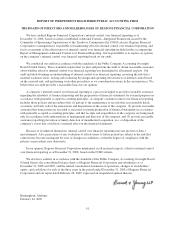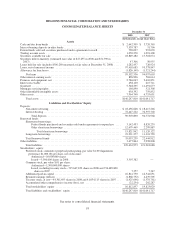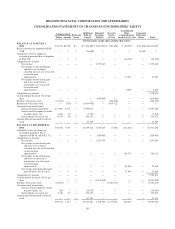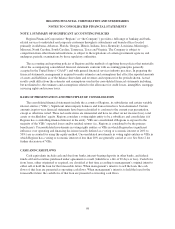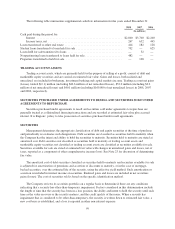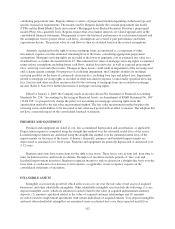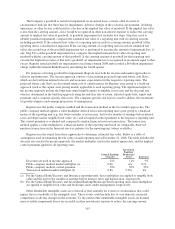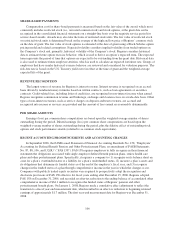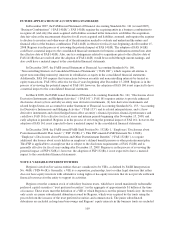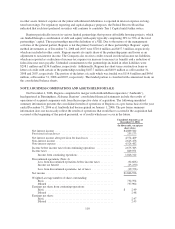Regions Bank 2008 Annual Report Download - page 111
Download and view the complete annual report
Please find page 111 of the 2008 Regions Bank annual report below. You can navigate through the pages in the report by either clicking on the pages listed below, or by using the keyword search tool below to find specific information within the annual report.ALLOWANCE FOR CREDIT LOSSES
Through provisions charged directly to expense, Regions has established an allowance for credit losses
(“allowance”). This allowance is comprised of two components: the allowance for loan losses, which is a contra-
asset to loans, and a reserve for unfunded credit commitments, which is recorded in other liabilities. The
allowance is reduced by actual losses and increased by recoveries, if any. Regions charges losses against the
allowance in the period the loss is confirmed.
The allowance is maintained at a level believed adequate by management to absorb probable losses inherent
in the loan portfolio. Management’s determination of the adequacy of the allowance is an ongoing, quarterly
process and is based on an evaluation of the loan portfolio, historical loan loss experience, current economic
conditions, collateral values of properties securing loans, volume, growth, quality and composition of the loan
portfolio, regulatory guidance, and other relevant factors. Unfavorable changes in any of these, or other factors,
or the availability of new information, could require that the allowance be adjusted in future periods. Actual
losses could vary from management’s estimates. Except for allowance on loans subject to Statement of Financial
Accounting Standards No. 114, “Accounting by Creditors for Impairment of a Loan” (“FAS 114”), no portion of
the resulting allowance is allocated to any individual credits or group of credits. The remaining allowance is
available to absorb losses from any and all loans.
Regions’ assessment of allowance levels is determined in accordance with regulatory guidelines, FAS 114
and Statement of Financial Accounting Standards No. 5, “Accounting for Contingencies” (“FAS 5”). In
determining the allowance, management uses information to stratify the loan portfolio into loan pools with
common risk characteristics. Loan pools in the portfolio are assigned estimated allowance amounts of loss based
on various factors and analyses, including but not limited to, current and historical loss experience trends and
levels of problem credits, current economic conditions, changes in product mix and underwriting. Loans deemed
to be impaired include non-accrual loans, excluding consumer loans, and troubled debt restructurings (“TDRs”).
Impaired loans, excluding consumer loans, with outstanding balances greater than $2.5 million are evaluated
individually rather than on a pool basis as described above. For these loans, Regions measures the level of
impairment based on the present value of the estimated projected cash flows, the estimated value of the collateral
or, if available, the observable market price. For consumer TDRs, Regions measures the level of impairment
based on pools of loans stratified by common risk characteristics.
In order to estimate a reserve for unfunded commitments, Regions uses a process consistent with that used
in developing the allowance for loan losses. Regions estimates future fundings, which are less than the total
unfunded commitment amounts, based on historical funding experience. Allowance for loan loss factors, which
are based on product and customer type and are consistent with the factors used for portfolio loans, are applied to
these funding estimates to arrive at the reserve balance. Changes in the reserve for unfunded commitments are
recognized in other non-interest expense.
ACCOUNTING FOR TRANSFERS AND SERVICING OF FINANCIAL ASSETS
Regions historically sold receivables, such as commercial loans, residential mortgage loans and dealer loans,
in securitizations and to third parties, including conduits. When Regions sold these receivables, it retained a
continuing interest in the form of interest-only strips, one or more subordinated tranches, servicing rights or cash
reserve accounts. These retained interests were initially recognized based on their respective allocated cost basis
on the date of transfer. Any gain or loss on the sale of the receivables depends in part on the previous carrying
amount of the financial assets involved in the transfer, allocated between the assets sold and the retained interests
based on their relative estimated fair value at the date of transfer. Retained interests in the subordinated tranches
and interest-only strips were recorded at fair value and included in securities available for sale. Subsequent
adjustments to fair value are recorded through other comprehensive income. Quoted market prices for these
assets are generally not available, so Regions estimates fair value based on the present value of expected future
cash flows using management’s best estimates of the key assumptions—expected credit losses, prepayment
speeds, weighted-average life, and discount rates commensurate with the inherent risks of the asset. In
101


